| Image | Plant | Status | Notes | Events |
|---|---|---|---|---|
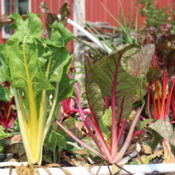 |
Swiss Chard (Beta vulgaris var. cicla 'Bright Lights') |
Have 9 Veg |
October 9, 2022: Seeds sown September 10, 2023: Seeds sown November 9, 2023: Seeds sown |
|
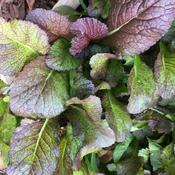 |
Mustard Greens (Brassica juncea 'Red Giant') |
Have 1 Veg Red Winter Garden 8 Veg 9 Veg 10 Veg |
Cold hardy to 25F degrees https://www.kitazawaseed.com/s... Sow: Jan 15-Apr 1; Aug 15-Oct 1 Germination: 4-10 days Maturity: 40-50 days |
May 19, 2021: Harvested September 12, 2021: Seeds sown September 15, 2021: Seeds germinated October 3, 2021: Seeds sown October 9, 2022: Seeds sown February 3, 2023: Seeds sown April 21, 2023: Harvested May 20, 2023: Plant Ended (Removed, Died, Discarded, etc) September 9, 2023: Seeds sown September 16, 2023: Seeds germinated October 26, 2023: Seeds sown November 12, 2023: Seeds sown (Greenhouse) March 2, 2024: Transplanted |
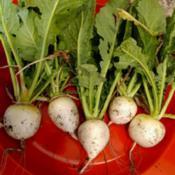 |
Turnip (Brassica rapa 'Hakurei') |
Have 1 Veg 9 Veg |
EARLY WHITE JAPANESE TURNIP Hybrid "very fast-growing and tender" uniform with "short hairless tops" "excellent sweet and mild flavor that makes it a favorite salad ingredient." https://www.kitazawaseed.com/s... sow: Oct 1-Dec 1 Germination: 4-7 days Maturity: 30 - 38 days Cold Hardy to 10 degrees Young, radish-size turnips are ready in about 30 days; full-size turnips are ready in about 40–50 days. Roots are smoothest when small. |
|
| Turnip (Brassica rapa 'Hidabeni') |
Have 1 Veg 9 Veg |
https://www.kitazawaseed.com/s... Sow: Jan 15-Apr 1; Sep1-Sep 15 Germination: 2-10 days Maturity: 45-50 days |
September 9, 2023: Seeds sown September 16, 2023: Seeds germinated October 12, 2023: Harvested (Greens) |
|
| Turnip (Brassica rapa 'Tsugaru Scarlet') |
Have 9 Veg |
October 2, 2022: Seeds sown January 2, 2023: Harvested April 21, 2023: Harvested |
||
| Bok Choy (Brassica rapa subsp. chinensis 'Jimao Choi') |
Have 9 Veg |
https://www.kitazawaseed.com/ Sow: Sept 1 Germination: Maturity: 20-30 days |
||
 |
Carrot (Daucus carota var. sativus 'Cosmic Purple') |
Have 1 Veg 9 Veg |
Botanical Interest Germination: 10-25 days Maturity: 70 days "Carrots are a cool season crop, with optimal growth between 60°-65°F, with a minimum of 45°F and a maximum of 75°F. Fall crops can be started in the heat of late summer to ensure that a substantial period of cool weather exists before frost. Color development is determined by temperature. Maximum color development occurs in the 60°-75°F optimal growth range. Temperatures over 70°F will also reduce root length, while temperatures below 60°F will produce longer roots. " UGA Crop Profile for Carrots "Purple carrots were prevalent in European and Middle Eastern markets until the orange carrot's introduction...Purple carrots originated over five thousand years ago in present-day Afghanistan in Central Asia. Considered to be one of the original carrots to be domesticated, many natural hybrids and mutants were developed and crossed with wild and cultivated varieties creating new cultivars varying in core color, size, and flavor. Purple carrots were then transported via seeds across Africa, Europe, and Eastern Asia and were sold during trade expeditions. Today Purple carrots are found at local farmers markets, specialty grocers, and in home gardens in North America, South America, Africa, Europe, Asia, and Australia. " - Specialty Produce Produces 6"–7" long conical roots with long tapered ends, purple skin and orange core. Cross between imperator and nantes types. Care should be taken to harvest carrots at optimum for the particular market because over-mature carrots can develop woody centers particularly in older varieties. Over-mature carrots are also more prone to breakage during harvest. However, delaying harvest by 7-10 days after the appropriate size has been reached will increase the sugar content in mild climatic conditions. Thus, it may be better to delay harvest by one to two weeks depending on the weather. Carrot (Daucus carota var. sativus) is a member of the Umbelliferae family. Other vegetable crops and herbs in this family include celery, parsnip, parsley, dill, caraway, anise, coriander and fennel. Domestic carrots may have evolved from a wild form similar to its relative known in North America as Queen Anne's Lace. The family name comes from the flower form, which is an umbel. Characteristic of most of the family's plants, an umbel has individual flower stalks originating from the same point on the stem. Carrots probably originated in Asia around northwest India. Cultivation of carrots for medicinal purposes began 2000 to 3000 years ago. They were used for a myriad of medicinal purposes including stomach ulcers, abscesses, bladder, liver and kidney problems, to aid in childbirth and even as aphrodisiacs. Cultivation of roots for consumption dates back to 600 A.D. when purple root types were grown in the area currently known as Afghanistan. Yellow types were eventually selected and produced in Syria and Iran in the ninth or tenth century. Carrots were introduced to China by the thirteenth century and cultivation spread from the Middle East to Italy, Spain and throughout Europe by the fourteenth century. Eventually, white and orange types were selected. Orange types, first grown in the Netherlands during the seventeenth century, were brought to North America by early settlers. The root was popular with Native Americans and production currently exists worldwide. One of the reasons production is so widespread is that carrots are the major single source of Vitamin A in the diets of many cultures. They are also a good source of other vitamins, minerals and fiber. https://extension.uga.edu/publ... Serving fresh in salads or vegetable platters, light sautéing or roasting showcases the dramatic colors. "The carrots can also be lightly sautéed or roasted to develop a sweet, caramelized flavor. Leafy tops of carrots can be blended into sauces, minced into salads, or lightly sautéed and served as a side dish. Purple carrots pair well with pomegranate seeds, hazelnuts, radishes, tomatoes, cheeses such as pecorino, cheddar, and parmesan, garlic, ginger, mushrooms, and potatoes." Avoid storing carrots with fruits, as fruits produce an ethylene gas which may make the carrots bitter. https://www.botanicalinterests... |
February 20, 2022: Seeds sown October 9, 2022: Seeds sown February 3, 2023: Seeds sown May 20, 2023: Harvested |
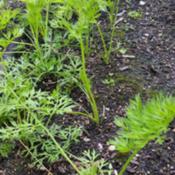 |
Carrot (Daucus carota var. sativus 'Little Fingers') |
Have 1 Veg 9 Veg |
Fall **** https://www.kitazawaseed.com/s... Sow: Jan 15-Mar 20; Aug 20-Sep 15 Germination: 8-10 days Maturity: 55-60 days |
March 11, 2021: Seeds sown May 8, 2021: Plant Ended (Removed, Died, Discarded, etc) August 7, 2021: Seeds sown September 12, 2021: Seeds sown October 9, 2022: Seeds sown |
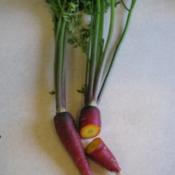 |
Carrot (Daucus carota var. sativus 'Purple Dragon') |
Have 9 Veg |
https://www.kitazawaseed.com/s... Sow: Jan 15 - Mar 20; Aug 20 - Sep 15 Germination: 14-21 days Maturity: 70-90 days |
September 12, 2021: Seeds sown October 9, 2022: Seeds sown |
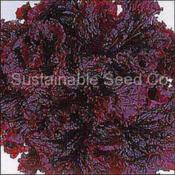 |
Lettuce (Lactuca sativa 'Red Velvet') |
Have 1 Veg 9 Veg |
||
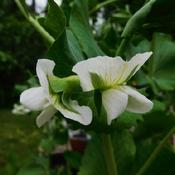 |
Snap Pea (Lathyrus oleraceus 'Cascadia') |
Prev 1 Veg 2 Veg 9 Veg 10 Veg |
BUSH PEA - vines to 30" Fedco HD https://www.homedepot.com/p/Bu... Sow: Jan-Feb; Sept-Oct Germination: 7-14 days Maturity: 58-65 days Culture: Sow as early as ground can be worked for best yields. Minimum soil temperature for pea seed germination: 40°. Optimal range 50–75°. Peas are legumes with moderate fertility requirements. Avoid excess nitrogen: they can fix their own. Use Legume Inoculant at planting. They prefer cool, moist weather and dislike dry heat. All peas produce more when staked; varieties over 2½' must be supported. Use either Trellis Netting or chicken wire. Install support at planting time to avoid disturbing seedlings. Plant 8–10 seeds/ft on each side of supports in double rows. Set supports for rows 3' apart (5' if very tall varieties). Young plants are very hardy but frost stops production at the blossom or pod stage. If you love peas as much as we do, try for a second crop in the fall. Timing is crucial, as peas ripen slowly in the cool of September, and frost will halt production. We recommend planting the first two weeks of July for a fall crop in central Maine. Warmer areas try later July. If the summer is hot, cool the soil with a hay mulch in advance of planting, or shade peas with tall crops to hold in soil moisture. Peas are 25% sucrose by weight and lose nearly half their sugars within 6 hours at room temperature. That's why they taste best grazed right off the vine. Keep cool and shell as soon as possible after picking for freezing. Not well adapted to southern climates where the spring heats up too quickly. Pam Dawling in Virginia has great success with Sugar Ann but cannot grow the tall longer-season Sugarsnap in her climate. Smooth-seeded peas germinate better in colder soils than wrinkle-seeded peas, but are not as sweet. Dawling suggests that forsythia flowering signals time to sow snap and snow peas. |
February 22, 2022: Seeds sown |
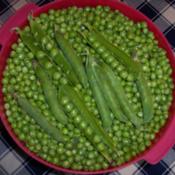 |
English Pea (Lathyrus oleraceus 'Green Arrow') |
Have 1 Veg 9 Veg |
BUSH PEA Fedco https://www.seedsavers.org/gre... Sow: Jan 15 – Feb 15; Sep Germination: 7-14 days Maturity: 60-70 days (65 days) Open-pollinated. The pea preferred by commercial growers, always on target for heavy yields. Sets the standard for midseason varieties. Long pods with up to 10 peas per pod (more typically 7–8) on vines up to 3'. Seems to withstand miserable and extreme weather better than other varieties. Easy-to-pick because pods tend to set in pairs at the top. Tolerant to F, DM, CTV, W. May have up to 11% taller off-types |
September 11, 2021: Seeds sown February 20, 2022: Seeds sown March 24, 2022: Seeds sown January 29, 2023: Seeds sown |
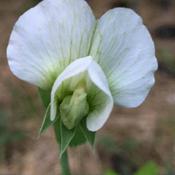 |
Snap Pea (Lathyrus oleraceus 'Sugar Daddy') |
Prev 1 Veg 9 Veg |
Sow: Jan 15-Feb 15; Sep 15-Oct 15 Germination: 7-14 days Maturity: 65 days - Thanksgiving |
August 23, 2020: Seeds sown September 11, 2021: Seeds sown |
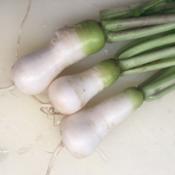 |
Radish (Raphanus sativus 'Altari Dochon 89') |
Have 1 Veg 9 Veg |
PONYTAIL RADISH Source: https://www.kitazawaseed.com/s... Source: https://kimchimarishop.com/pro... Sow: Sept 1-Oct 15; Jan 15-Apr 1 Germination: 4 days Germination Temp: 55-70°F Maturity: 55-60 days (spring), 35-40 days (fall) Recipe: https://kimchimari.com/radish-... https://theprudentgarden.com/c... Altari radish kimchi, also known as Chonggak kimchi, is popular in Korea. Altari radish grown in the fall are preferred, as they are sweeter and less pungent. Radishes get their sweetness from glucose and fructose. Kimchi for Bachelors Chonggak translates to bachelor in Korean. This kimchi got it's name because the radish used for the kimchi resembles a ponytail. Back in the old days in Korea, young men wore their hair in a long braid. Because the radish stem resembles the braid, the Altari radish was nicknamed bachelor, or Chonggak. Whether or not it is a favorite of bachelors, this particular kimchi is my favorite and very popular in Korean cuisine. |
March 11, 2021: Seeds sown May 22, 2021: Harvested September 11, 2021: Seeds sown September 15, 2021: Seeds germinated September 19, 2022: Seeds sown January 2, 2023: Harvested September 9, 2023: Seeds sown September 14, 2023: Seeds germinated |
 |
Radish (Raphanus sativus 'Bora King') |
Have 1 Veg 9 Veg |
https://www.kitazawaseed.com/s... Sow: Sept 1-Oct 15; Jan 15-Apr 1 Germination: 3-10 days Maturity: 60 days https://www.foodfidelity.com/b... https://holycowvegan.net/mooli... Radish " Korean Radish Bora King, Hybrid Raphanus sativus This beautiful daikon has purple flesh and skin. It matures at 8-10" long, weighs 2-3 lbs, and has late pithiness. The plant is slow to bolt, and the leaves are deeply serrated and delicious. An excellent variety for specialty market growers. Cool season Approx. 100-200 seeds in packet. Maturity: Approx. 60-65 days Planting season: Spring or fall Cultivation: Prepare fertile, well-drained soil. Sow seeds in spring after last frost or in late summer/early fall in a warm, sunny location. Keep soil moist. Fertilize as needed. Germination Temperature 55-70°F Seed Depth 1/2" Seed Spacing 1" Thin To 4-6" Row Distance 18-24" Please note: Maturity, adaptability and disease tolerance may differ under your specific climate and/or growing conditions. Culinary tips: Use in soup, salad, tsukemono (pickled) or fresh. Daikon oroshi (coarsely grated daikon using a Japanese grater) is delicious in sauces used for soba noodles, tempura, and sashimi. The leaves are eaten as well. |
March 11, 2021: Seeds sown May 22, 2021: Harvested September 12, 2021: Seeds sown September 15, 2021: Seeds germinated September 19, 2022: Seeds sown January 2, 2023: Harvested September 9, 2023: Seeds sown September 14, 2023: Seeds germinated |
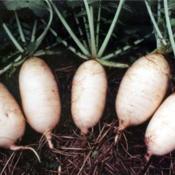 |
Radish (Raphanus sativus 'Formosa Giant Luo Buo') |
Have 9 Veg |
Sow: Sep 1-Sep 20 Germination: 3-4 days Maturity: 80-100 days |
September 12, 2021: Seeds sown September 15, 2021: Seeds germinated September 19, 2022: Seeds sown January 2, 2023: Harvested |
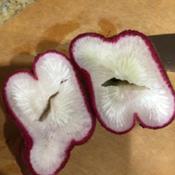 |
Radish (Raphanus sativus 'French Breakfast') |
Have 1 Veg 9 Veg |
https://www.kitazawaseed.com/s... Sow Jan 15-Apr 1; Sep 1-Oct 15 30 days https://www.youtube.com/watch?... Raphanus sativus 'French Breakfast' is a popular summer radish, bearing oval, crisp scarlet and white roots. Grow in moist but well-drained soil in full sun to partial shade. Early thinning is important, or plants make leaf at the expense of usable roots. French breakfast is the name of an heirloom cultivar of radish that was introduced in 1879 and became a popular radish in Paris produce markets. It is oblong, between two and four inches in length. This radish has a reddish-pink color, similar to the salad radishes popular in the U.S., with a white tip at the root and bright leafy greens. Where the North American salad radish is peppery and spicy, the French breakfast radish is much milder with a sweeter flavor. Although named "French breakfast," the French do not eat radishes as part of their first meal of the day. They do eat them as a snack, sometimes dipped in salt, sometimes lightly buttered and then dipped in salt, and sometimes sliced and served on a toasted, buttered baguette along with a sprinkling of salt. The Germans eat radishes similarly, although they're known to wash this snack down with a cold beer. https://www.thespruceeats.com/... How to Use French Breakfast Radishes To serve French breakfast radishes in the traditional Parisian manner, you need the radishes, bread, butter, salt, and pepper. Simply trim off the leafy tops, leaving a bit of stem still attached, wash and dry the radishes thoroughly, and then place them in a bowl. Toast really good, crusty bread, ideally a light, crackly baguette, and spoon some sweet butter into a small dish and sprinkle it with salt and pepper. Holding the radish by the stem, take a bite; while chewing, butter some bread, and then take a bite of that. That is how radis beurre et pain grillé, also known as radishes with buttered toast, is enjoyed. The radish can also be part of a crudite platter or sliced and added to a salad. The greens can be used raw in a salad as well or cooked along with other leafy greens. How to Cook With French Breakfast Radish Just like with ordinary red radishes, cooking brings out the sweetness in a French breakfast radish, and roasting and sautéeing are common methods of preparation. It should be washed, and the leafy greens removed before cooking. The radish can be roasted whole or sliced and sautéd to serve as a side dish. It can also be part of a stir-fry, cooked along with other vegetables, or even added into a puréed vegetable soup. The French breakfast radish can also be pickled or braised. The greens can be chopped and cooked separately, or the entire radish—root and leaves—can be enjoyed in a dish. What Do They Taste Like? French breakfast radishes are milder and sweeter than common red radishes while still retaining a hint of that peppery, mustardy piquancy that is associated with radishes. Spring and fall radishes will be milder than ones grown in summer—the warmer the soil, the spicier the radish. French Breakfast Radish Recipes Radishes are crispy and flavorful eaten out-of-hand, add color, flavor, and texture to salads, and are ideal as a vegetable dipper with guacamole. They can also be cooked for a less spicy and sweeter flavor. Roasted Radishes https://www.thespruceeats.com/... Quick Refrigerator-Pickled Radishes https://www.thespruceeats.com/... Radish Potato Soup https://www.thespruceeats.com/... |
August 23, 2020: Seeds sown September 19, 2022: Seeds sown September 9, 2023: Seeds sown September 16, 2023: Seeds germinated November 1, 2023: Harvested |
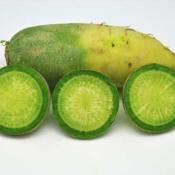 |
Daikon Radish (Raphanus sativus 'Green Luobo') |
Have 9 Veg |
60 Days to maturity. Green Meat Luobo Chinese Radish Heirloom Seeds. Cool Season Annual. grow as big as 10" long! Sweet and spicy, these two-toned roots may just be your next favorite pickled vegetable. Lime-green upper half with a white tip, we harvest uniformly shaped roots at lengths of 5-10". Radishes will taste hotter as they mature, especially if exposed to warm weather. Green Luobo has traditionally been preserved through fermentation, which cools the spice and transforms the flavor from spicy to amazing! Cooking also reduces the spice. If you want milder, raw radishes, try planting mid-summer for fall harvest and winter use. Enjoy by grating the root and mixing it into a slaw or salad, slicing it thinly onto a taco, or adding it to a stir-fry or soup. Even the greens are edible and nutritious! Not for spring planting because plants may bolt. For summer planting and fall harvest. Fall harvested roots will store until early spring in a cellar (or the fridge). Said to have originated in China, this variety is now popular around the world. Applications Green Meat radishes have a mildly pungent flavor and crisp texture well suited for fresh and cooked preparations. The radishes can be utilized in recipes calling for daikon radish as they share a similar texture and flavor profile. When raw, the roots can be sliced thin and served on appetizer plates with cream-based dips and soft cheeses, cut and spread over buttered toast, chopped and tossed into salads, grated into coleslaw, or thinly sliced and incorporated as a crunchy element into bao buns, sandwiches, and tacos. Green Meat radishes can also be grated and served as a condiment with sushi or sashimi, incorporated into soups and stews, mixed into stir-fries, or roasted as a simple side dish. In Asia, Green Meat radishes are popularly pickled for extended use as a tangy, fermented bite. The roots are sometimes used in kimchi, chopped for relishes, or pickled with Sichuan peppers for a spicy kick. In addition to the roots, Green Meat radish leaves are also edible and can be sauteed, steamed, blanched, or stir-fried, similarly to mustard greens. Green Meat radishes pair well with aromatics such as ginger, lemongrass, onions, garlic, and peppers, mushrooms, carrots, cucumbers, meats including pork, poultry, beef, and fish, citrus, miso, and soy sauce. Whole, unwashed Green Meat radishes will keep 1 to 2 weeks stored in a plastic bag in the refrigerator. Radish greens should be removed prior to storage and kept in a separate plastic bag for 1 to 3 days. Ethnic/Cultural Info In the city of Qingdao in the Shandong Province, China, the annual Qingdao Radish Festival celebrates the importance of radishes within Chinese cuisine and honors the root's intertwined history with Chinese folklore. The festival's history can be traced over 600 years ago to the Ming Dynasty, where radishes were traditionally eaten on the ninth day of the Lunar New Year for good health and luck. The ninth day of the Lunar New Year is symbolic of the start of spring, and in Shandong, consuming radishes in a spicy soup provided cleansing for the digestive tract and protection from disease in the year to come. In the modern-day, Chinese families still practice the tradition of consuming spicy radish soup, and the festival captures the essence and tradition of the ancient folklore through elaborate sculptures created from various radish varieties. The radish carving contest features over 30 master carvers from China. The sculptures are displayed throughout the event for visitors to admire, vote for, and enjoy, and the winning carver will receive the highest honor and respect for the following year. Green Meat radishes are often used in the carvings for their pale green hue, and the sculptures typically depict mythical zodiac creatures, dragons, koi fish, ducks, and buddhas. These creatures are chosen based on the annual theme and provide visitors with a visual image of the region's cultural heritage. The Qingdao Radish Festival also draws approximately 150,000 residents of Qingdao into the festival to purchase radishes. Many different varieties of radishes are sold at the festival, including Green Meat radishes, and by the end of the festival, over eight tons of radishes have typically been sold. In addition to fresh radishes, the festival also features radish exhibits, other contests, cooking demonstrations, and market goods. Geography/History Green Meat radishes are believed by experts to be native to Northern China and have been cultivated since ancient times. The first green radish recorded was noted in texts from the Shang Dynasty, and over time, the mild roots became widely incorporated into culinary preparations, medicinal applications, and used for ornamental purposes across China. Green Meat radishes were later introduced to Central Asia and Europe in the mid 17th century, where they were planted in home gardens. The green roots thrived in colder temperatures and had extended storage capabilities, making them favorable for many areas of Europe, and the radishes were eventually brought to the New World. Today Green Meat radishes are widely available in Asia and are considered a special radish in Europe and North America. When in season, the green roots are sold through farmer's markets, Asian grocers, distributors, and grown in home gardens. Nutritional Value Green Meat radishes are an excellent source of vitamin C to strengthen the immune system, boost collagen production within the skin, and reduce inflammation. The roots are also a good source of potassium to balance fluid levels, folate to develop red blood cells, and contain lower amounts of magnesium, calcium, copper, vitamin K, and phosphorus. In Traditional Chinese Medicine, radishes are used as a digestive aid and are believed to promote health and wellness, particularly in the respiratory system. The roots are commonly consumed raw or juiced to help reduce phlegm and coughs. https://www.ohmyfoodrecipes.co... |
September 19, 2022: Seeds sown September 9, 2023: Seeds sown November 11, 2023: Harvested |
| Daikon Radish (Raphanus sativus 'Mantanghong') |
Have 9 Veg |
https://www.kitazawaseed.com/s... Sow: Jan 15-Feb 15; Sept 1-Oct 1 Germination: 3-4 days Maturity: 60-70 days |
September 11, 2021: Seeds sown September 19, 2022: Seeds sown January 2, 2023: Harvested September 9, 2023: Seeds sown |
|
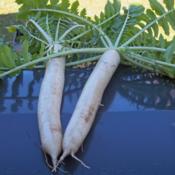 |
Daikon Radish (Raphanus sativus 'Minowase Summer Cross #3') |
Have 9 Veg |
https://www.kitazawaseed.com/s... Sow: Sept 1-Oct 15; Germination: 3-10 days Maturity: 60 days |
September 12, 2021: Seeds sown September 15, 2021: Seeds germinated September 9, 2022: Seeds sown January 2, 2023: Harvested |